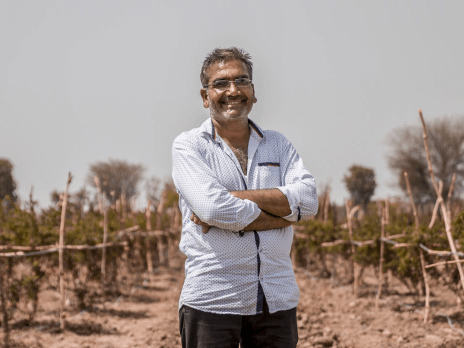Kishan’s Story
Kishan is a 45-year old farmer with twelve years of schooling. He lives in Madara with his wife and two sons and exemplifies JIVA’s innovative approach and emphasis on empowering local community members. Kishan owns 10 bighas (1.7 ha) of irrigated land, which he cultivates with his wife to support their family. He used to grow cotton, maize, and wheat but became interested in pomegranate production after seeing the crop’s potential during an exposure visit conducted by JIVA.
In July 2015, Kishan planted 600 pomegranate saplings on 4.5 bighas (.75 ha) of land and installed a solar-powered drip irrigation system. Excited to harvest the new crop, Kishan allowed the flowers on his one-year-old plants to bloom into fruits.1 Despite heavy and continuous rainfall that damaged the nascent pomegranates, he earned $588 from selling his first harvest in July 2016 while gifting a portion to family and friends. Kishan also earned over $4,000 in additional income by experimenting with a variety of intercropping combinations with his pomegranate plants, including fodder, wheat, papaya, and vegetables.

Convinced of pomegranate’s income-generating potential, Kishan scaled back his intercropping activities in 2017 to focus on maximizing his pomegranate yields. His efforts paid dividends as his two-year-old plants, producing at 30% the capacity of a fully mature pomegranate tree, yielded a harvest of 3,500 kg. Although a glut in the pomegranate market lowered wholesale prices,2 Kishan sold the majority of his harvest to earn $7,588 in gross income. When combined with income from his fodder and papaya intercrops, Kishan’s net income of $1,797 per bigha3 surpasses the net income per bigha of a cotton-wheat intercrop, traditionally the most profitable cropping scheme.4 As Kishan’s pomegranate orchard enters its third year, he is expected to earn a net income per bigha of 2-3 times the amount of a cotton-wheat intercrop, with his output continuing to grow until his orchard reaches full maturity during the July 2020 harvest.

Kishan’s enthusiastic adoption of pomegranate and willingness to innovate demonstrate two important choices that farmers must make when managing their pomegranate orchards. First, they must weigh the decision to intercrop. Second, farmers must decide whether to diversify their risk by splitting their harvest across multiple seasons or attempting to maximize income by choosing to harvest during the peak season. While farmers typically harvest their pomegranate and receive the highest prices in July, farmers can diversify their harvests and spread out weather and price-related risks by harvesting portions of their orchard throughout the year.5 JIVA supports farmers in making these critical decisions for their orchards by addressing these risk-reward trade-offs during pomegranate trainings and farmers meetings.
1 JIVA advises farmers to remove the flowers on pomegranate trees during their first year, thereby maximizing plant growth by preventing fruits from forming
2 An extended stretch of rainfall and flooding in Gujarat, the main pomegranate-producing area in the region, led farmers to harvest their pomegranate orchards simultaneously in order to avoid damage from pests and disease
3 All figures are in USD Purchasing Power Parity (PPP)
4 A cotton-wheat cropping scheme produces an average net income of $1,465/bigha per year, although this average varies depending on market prices. During a strong market year, the cotton-wheat intercrop can yield up to $2,035/bigha.
5 Depending on when pomegranate flowers are allowed to bloom into fruits, pomegranates can be harvested in March/ April, July/ August, or October/ November.

